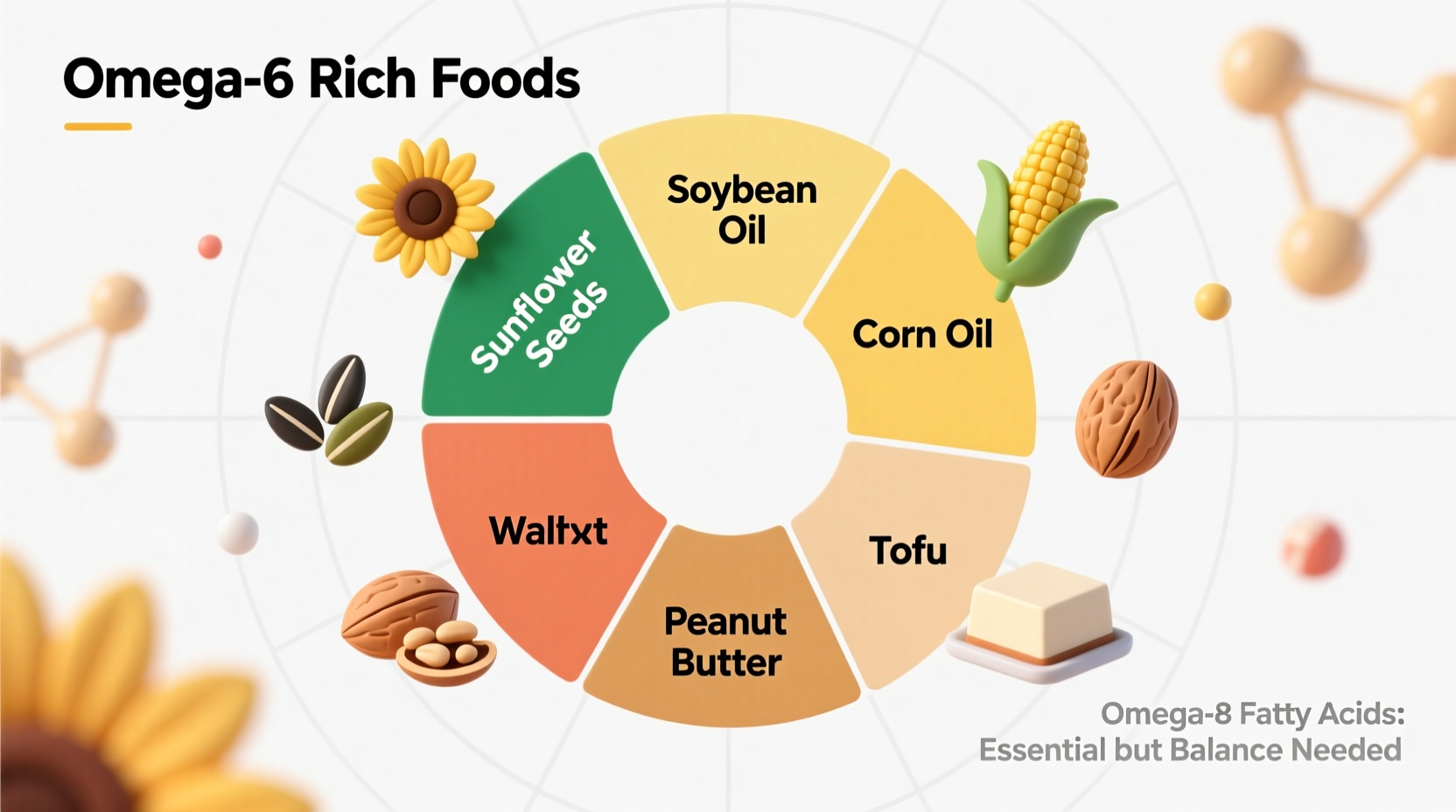Discover exactly which foods deliver optimal omega-6 fatty acids while maintaining a healthy balance with omega-3s. This evidence-based guide reveals the top dietary sources, explains why the omega-6 to omega-3 ratio matters for inflammation control, and provides practical strategies for incorporating these essential fats into your daily meals without overconsumption.
Understanding Omega-6 Fatty Acids
Omega-6 fatty acids represent a family of polyunsaturated fats that your body cannot produce on its own. Linoleic acid (LA) serves as the primary omega-6 compound found in foods, which your body converts into other important compounds like arachidonic acid (AA). These fats play crucial roles in brain function, skin health, and hormone production. Unlike saturated fats, omega-6s provide essential building blocks that support cellular membranes and inflammatory responses necessary for healing.
While omega-6s often face criticism in popular media, they're actually vital for health when consumed in appropriate amounts. The real issue lies in the modern Western diet's extreme imbalance between omega-6 and omega-3 fatty acids. Where our ancestors maintained a ratio closer to 1:1 or 2:1, contemporary diets often reach 15:1 or higher, potentially contributing to chronic inflammation when omega-3 intake remains insufficient.
Top Food Sources of Omega-6 Fatty Acids
Certain foods naturally contain higher concentrations of omega-6 fatty acids. Understanding these sources helps you make informed dietary choices while maintaining proper balance with omega-3s.
Vegetable Oils: The Highest Concentrations
Most cooking oils represent concentrated sources of omega-6. While convenient for cooking, their high omega-6 content means they should be used judiciously, especially if you're trying to improve your omega-6 to omega-3 ratio.
| Oil Type | Omega-6 Content (per tablespoon) | Omega-6 to Omega-3 Ratio |
|---|---|---|
| Soybean oil | 7.9g | 7:1 |
| Sunflower oil | 9.2g | 340:1 |
| Safflower oil | 10.2g | 75:1 |
| Corn oil | 7.2g | 46:1 |
| Olive oil | 1.4g | 13:1 |
Data sourced from the USDA FoodData Central database shows significant variation in omega-6 concentrations across different oils. This explains why replacing common cooking oils with olive oil can substantially improve your fatty acid balance.
Nuts and Seeds: Nutrient-Dense Options
Beyond oils, whole foods provide omega-6 along with valuable fiber, protein, and other nutrients. These make excellent snack options when consumed in appropriate portions.
- Walnuts: While known for omega-3s, walnuts also contain significant omega-6 (3.4g per ounce)
- Sunflower seeds: Deliver 9.2g of omega-6 per quarter cup serving
- Pumpkin seeds: Provide 5.4g of omega-6 per ounce with substantial magnesium
- Sesame seeds: Contain 5.8g of omega-6 per ounce plus calcium and iron
- Pine nuts: Offer 4.3g of omega-6 per ounce with zinc and manganese
Animal-Based Sources
While plant foods dominate the omega-6 landscape, certain animal products also contribute to your intake:
- Poultry: Chicken and turkey contain moderate omega-6 levels influenced by feed
- Eggs: Particularly from conventionally raised chickens with higher omega-6 content
- Grass-fed beef: Contains lower omega-6 than grain-fed varieties

The Critical Omega-6 to Omega-3 Balance
Research published in the National Institutes of Health indicates that maintaining an appropriate omega-6 to omega-3 ratio significantly impacts inflammatory processes. Historical dietary patterns maintained ratios between 1:1 and 4:1, while modern Western diets often exceed 15:1 due to increased consumption of processed foods and vegetable oils.
This imbalance matters because both fatty acid families compete for the same metabolic pathways. Excessive omega-6 consumption without sufficient omega-3s can promote inflammatory responses linked to chronic conditions. The American Heart Association recommends focusing on increasing omega-3 intake rather than strictly limiting omega-6, as both are essential fats required for optimal health.
Practical Dietary Integration Strategies
Instead of eliminating omega-6 rich foods, implement these evidence-based approaches to maintain balance:
Smart Cooking Oil Selection
Replace common high-omega-6 oils with alternatives that offer better fatty acid profiles. Use olive oil for low-heat cooking and dressings, avocado oil for medium-heat applications, and save high-omega-6 oils like sunflower or safflower for occasional use only. This simple switch can dramatically improve your overall fatty acid ratio without eliminating valuable food sources.
Portion Control for Nuts and Seeds
Enjoy these nutrient-dense foods in appropriate portions—typically one ounce daily. Measure servings rather than eating directly from the container to prevent unintentional overconsumption of omega-6 fats. Combine with omega-3 rich foods like chia seeds or flaxseeds to create balanced snacks.
Strategic Meal Planning
When planning meals, consciously pair omega-6 rich foods with omega-3 sources. For example, add walnuts to a spinach salad containing salmon, or sprinkle pumpkin seeds over grilled mackerel. This approach naturally balances your fatty acid intake without requiring complicated calculations.
Addressing Common Misconceptions
Several myths persist about omega-6 fatty acids that deserve clarification based on current scientific understanding:
"All Omega-6 Fats Promote Inflammation"
While certain omega-6 derivatives like arachidonic acid can contribute to inflammatory pathways, the precursor linoleic acid actually demonstrates anti-inflammatory properties. The relationship between omega-6 and inflammation follows a U-shaped curve—both deficiency and extreme excess cause problems, while adequate intake supports healthy inflammatory responses.
"You Should Avoid All High Omega-6 Foods"
This extreme approach ignores the nutritional value of omega-6 rich foods. Nuts, seeds, and poultry provide essential nutrients beyond fatty acids. Rather than elimination, focus on balance by increasing omega-3 intake through fatty fish, flaxseeds, and walnuts while maintaining moderate omega-6 consumption from whole food sources.
Evidence-Based Insights on Omega-6 Consumption
A timeline analysis of dietary patterns reveals significant shifts in omega-6 consumption over recent decades. According to research in the National Library of Medicine, omega-6 intake has increased approximately 250% since the early 20th century, primarily through increased consumption of processed foods and industrial seed oils.
This historical perspective helps explain why modern dietary recommendations emphasize balance rather than elimination. The context boundaries for omega-6 become problematic primarily when:
- Consumption exceeds 10% of total daily calories
- Omega-3 intake remains consistently low
- Processed foods dominate the diet
- Individuals have pre-existing inflammatory conditions
For most healthy individuals following a balanced diet with adequate omega-3s, typical omega-6 intake from whole foods presents no health concerns. The key lies in understanding your personal dietary context and making informed choices accordingly.











 浙公网安备
33010002000092号
浙公网安备
33010002000092号 浙B2-20120091-4
浙B2-20120091-4